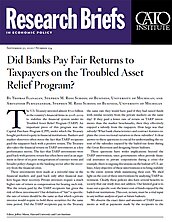These investments were made at a stressful time in the financial markets and paid back only after financial markets began their recovery. Private investors require a much higher rate of return as compensation for bearing such risk. Was the return paid by the TARP recipients fair given the risk of these investments? Our definition of “fair” is specific: the rate of return should be the same as that which a private investor would require to hold these securities for the same time period. Did the TARP recipients pay to the Treasury the same rate they would have paid if they had raised funds with similar security from the private markets on the same day? If they paid a lower rate of return on TARP investments than the market benchmarks, then they effectively enjoyed a subsidy from the taxpayers. How large was that subsidy? What bank characteristics and contract features explain the cross-sectional variation in these subsidies? A clear answer to these questions is crucial for understanding the extent of the subsidies enjoyed by the bailed-out firms during the Great Recession and designing future bailouts.
These questions have wider implications beyond the TARP intervention, since governments often provide financial assistance to private corporations during a crisis—for example, there is ongoing discussions on the bailout of U.S. airlines. A key objective of these interventions is to bring stability to the entire system while minimizing their cost. We shed light on the cost of these interventions by analyzing TARP investment. Clearly, these policies also have several benefits to society that our study does not address. Our limited goal is to tease out a specific cost: the lower cost of funds enjoyed by the bailed-out institutions. This cost, in turn, must be a vital input to any welfare analysis of past or future bailouts.
We observe the exact dates and amounts of TARP investments as well as payments made by the recipients to the Treasury, including the cash flows received from dividend payments, principal repayment, and proceeds from the exercise of the warrants that came with the preferred equity investments. Using this information, we compute the realized returns received by the Treasury, which we label as the TARP’s return. We compare the TARP’s return to carefully selected benchmarks on other securities with comparable risk. We focus on the value-weighted returns, weighted by the amount the Treasury invests in a given firm, in our discussions, as it better captures the economic magnitude of the subsidy.
As per the contract terms, preferred equity issued under the TARP had the same seniority as the existing preferred equity of the recipient banks. Thus market-based returns on the existing preferred equity of the same bank over the same time horizon provide a nearly ideal benchmark against which we can evaluate the TARP’s return. This a powerful benchmark because it controls for the bank’s risk, the security’s seniority, and the timing of the investment by design. Our approach obviates the need to rely on an explicit asset pricing model: we simply compare returns on two securities with similar risk issued by the same firm over the same time horizon.
While not all TARP recipients had actively traded preferred equity outstanding at the time of TARP investment, the largest ones did. We have data on preferred equity returns for 20 of the largest recipients, covering about 80 percent of total investments made under the plan. Therefore, we can get a reasonable estimate of the value-weighted subsidy based on this sample. TARP recipients paid 11 percent annualized return to the taxpayers compared with the benchmark’s annualized return of 39 percent over the same time horizon. In other words, TARP recipients received a considerable subsidy in the form of a lower cost of capital on the TARP. On a bank-by-bank basis, 19 of the 20 TARP recipients paid lower returns to the Treasury than those on their existing preferred shares in the market.
Our results raise an important economic question about the source of the subsidy. At a broad level, market participants faced two types of risk during the early days of the crisis: the uncertainty about the policy intervention itself and, conditional on the resolution of this uncertainty, the risk of investing in financial institutions with high default risk. Our main conclusion that the bailed-out institutions received cheaper funds remains the same regardless of the source of the subsidy. Since we measure returns from the date of each investment, and the first such investments were made two weeks after the CPP policy announcement, it is unlikely that our subsidy estimates include a premium demanded by private investors to resolve this specific policy uncertainty.
In sum, these results show that TARP recipients paid a considerably lower rate of return to the taxpayers compared with market benchmarks with similar or lower risk: banks’ preferred equity, the S&P’s preferred equity index, portfolios of preferred equity and warrants, banks’ senior bonds, and banks’ preferred equity investments made a year later.
In terms of bank characteristics, we show that the subsidy, defined as the difference between returns earned by the TARP and the benchmark, is higher for larger banks, high-beta banks, and banks with larger trading income. TARP investment did not sufficiently differentiate across banks with varying degrees of risk or the timing of the investment. For example, the terms for coupon payment were similar among banks. As a result, riskier banks ended up with higher subsidy compared with market benchmarks.
Overall, our results show that even though banks repaid the investments with a positive return, it was considerably below reasonable market-based benchmarks. Further, banks enjoyed significant concessions by renegotiating these contracts ex post. Shareholders and managers seemed to benefit from the renegotiation.
NOTE:
This research brief is based on Thomas Flanagan and Amiyatosh Purnanandam, “Did Banks Pay ‘Fair’ Returns to Taxpayers on TARP?,” SSRN, May 7, 2020, https://papers.ssrn.com/sol3/papers.cfm?abstract_id=3595763.

